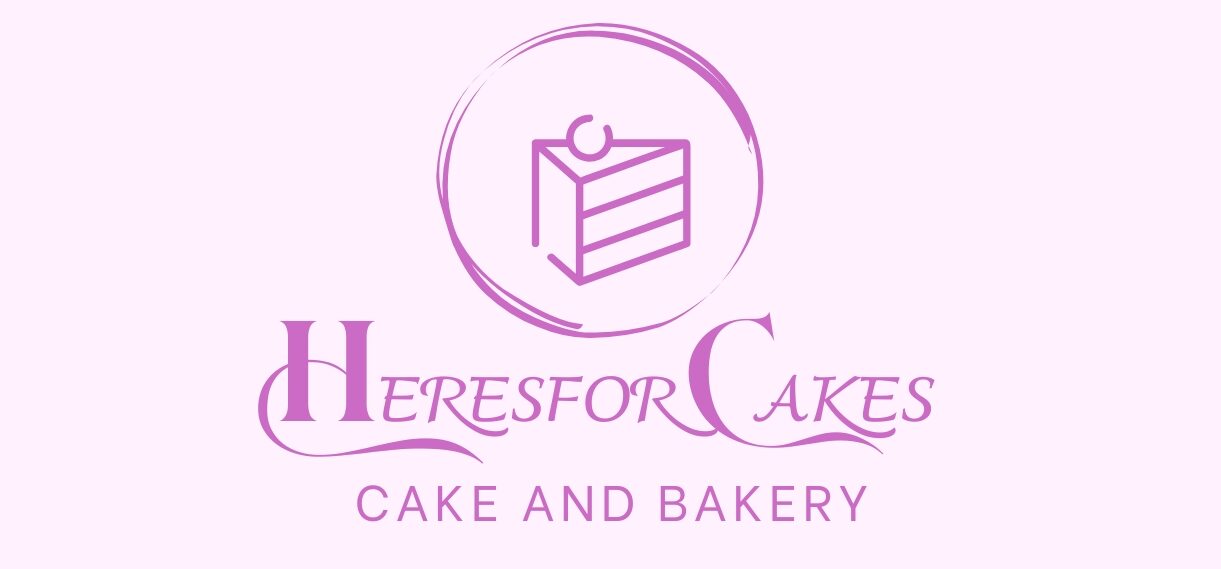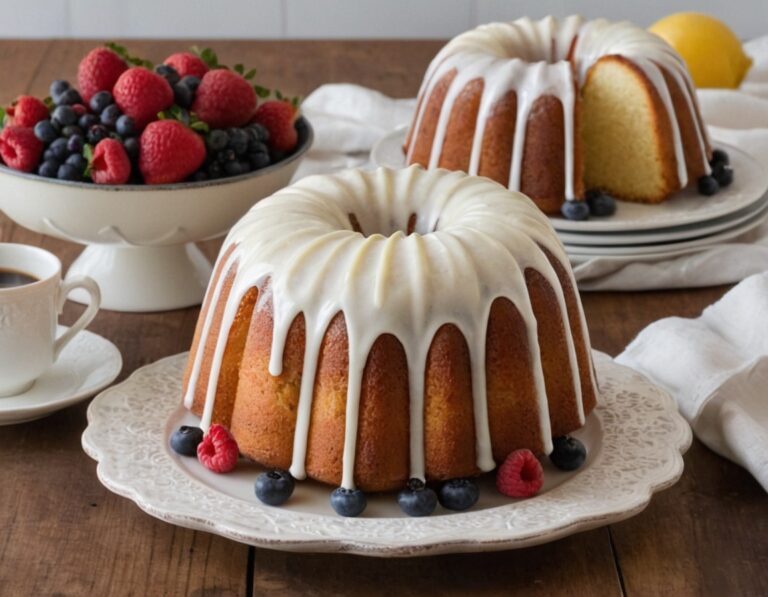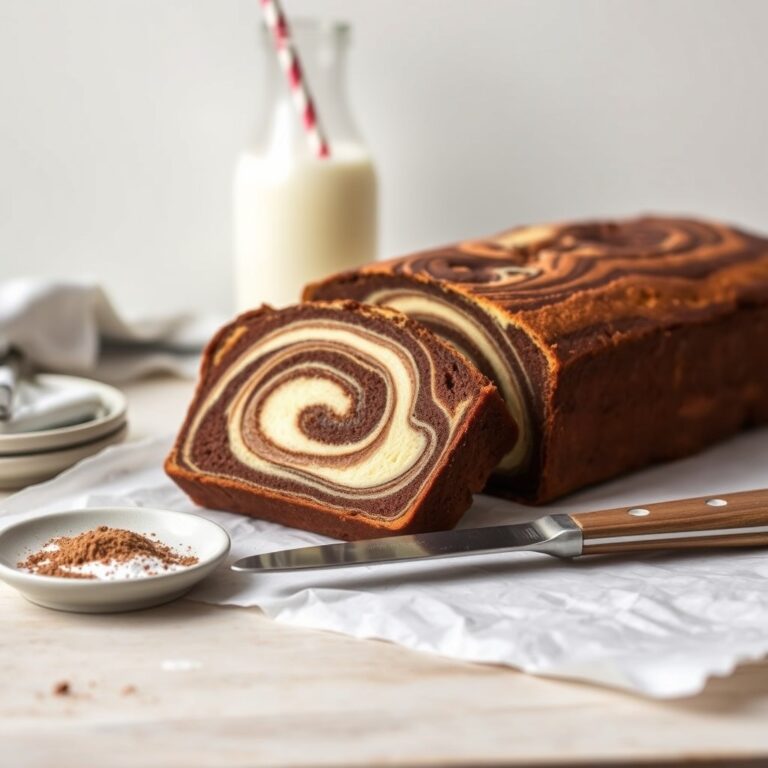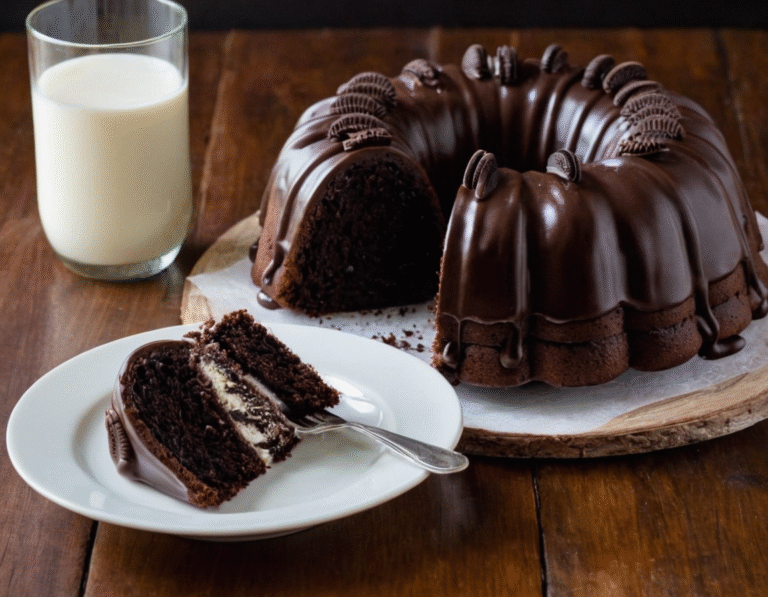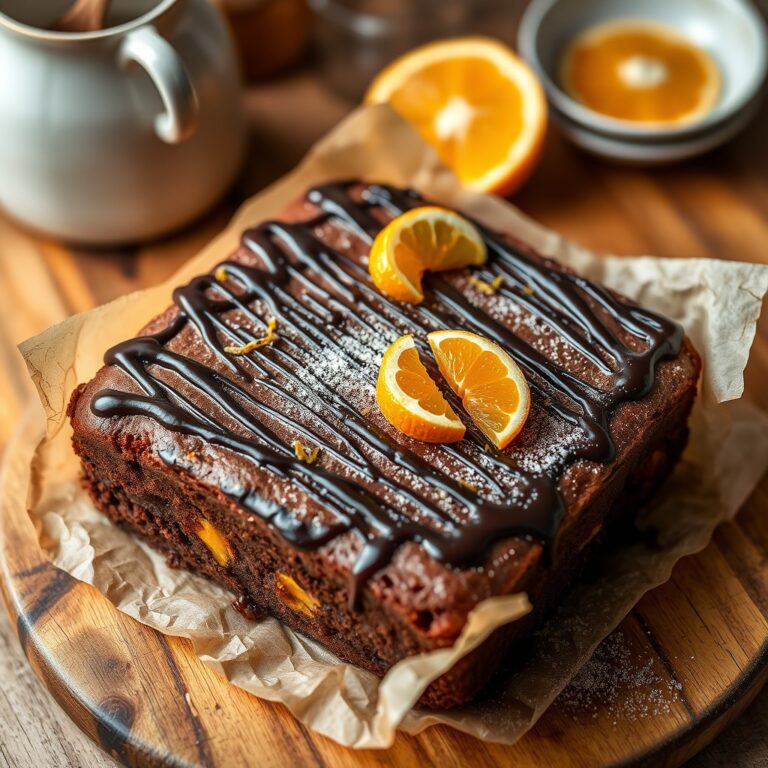Easy Cozy Eggnog Bread Recipe
Eggnog bread is the perfect festive treat that bridges the comforting warmth of homemade baked goods with the nostalgic flavors of the holiday season. This delightful loaf combines the rich, creamy essence of traditional eggnog with warm spices like nutmeg and cinnamon, making it an irresistible addition to any winter breakfast table, brunch spread, or dessert lineup. Whether you’re hosting a holiday gathering or looking for a cozy treat to enjoy with a cup of tea or coffee, this eggnog bread delivers a beautiful balance of flavor and texture.
What makes eggnog bread so special isn’t just the taste—it’s the mood it creates. The moment you start baking, the house fills with the aromas of vanilla, spice, and sweetness, creating an inviting atmosphere that captures the spirit of the holidays. But don’t be fooled into thinking this bread is only meant for December. Thanks to easily available store-bought or homemade non-alcoholic eggnog, you can enjoy it year-round. Its soft, tender crumb and subtly spiced notes make it a favorite for people of all ages.
In the U.S., quick breads like banana bread and pumpkin bread are staples in many households, and eggnog bread offers a unique twist on these classics. It’s simple to prepare, doesn’t require yeast or kneading, and is often topped with a sweet glaze that enhances its flavor and visual appeal. That means you don’t need to be an expert baker to pull off a stunning result.
Moreover, it’s highly customizable. You can add chopped nuts for texture, dried cranberries for tartness, or even a swirl of cream cheese for richness. For those avoiding alcohol, this recipe uses only non-alcoholic eggnog, ensuring it remains a family-friendly, all-ages treat.
Whether you’re gifting loaves during the holidays or preparing a cozy breakfast-in-bed treat, eggnog bread brings seasonal comfort in every slice. Read on to learn what ingredients you’ll need to get started on this festive baking adventure.
What You’ll Need
Creating the perfect eggnog bread starts with selecting the right ingredients. Although this recipe is relatively simple, using high-quality components will elevate your bread from good to truly memorable. Below is a breakdown of everything you’ll need, along with insights on each ingredient’s role in achieving the perfect texture and flavor.
Dry Ingredients:
- All-Purpose Flour (2 cups): The base of the bread, providing structure. Make sure to spoon and level the flour into your measuring cup to avoid overpacking, which can lead to a dense loaf.
- Granulated Sugar (1 cup): Adds sweetness and also contributes to the tender texture of the bread.
- Baking Powder (2 teaspoons): Acts as a leavening agent to give the bread its rise.
- Salt (½ teaspoon): Enhances all the other flavors, especially the spices.
- Ground Nutmeg (1 teaspoon): A must-have spice for anything eggnog related. It lends warmth and depth to the bread.
- Ground Cinnamon (½ teaspoon): Adds a subtle spicy sweetness that complements the nutmeg and ties in the holiday theme.
Wet Ingredients:
- Eggs (2 large): Essential for binding the ingredients and creating a moist texture.
- Non-Alcoholic Eggnog (1 cup): This is the star of the show. Choose a high-quality, creamy version for the best flavor. Make sure it’s non-alcoholic to keep the bread family-friendly.
- Unsalted Butter (½ cup, melted): Adds richness and moisture. Melted butter helps ensure the bread stays soft without being greasy.
- Vanilla Extract (1½ teaspoons): Enhances the overall flavor and adds a sweet aroma.
Optional Add-ins and Toppings:
- Chopped Pecans or Walnuts (½ cup): For added texture and a nutty crunch.
- Dried Cranberries (¼ cup): These offer a tangy contrast to the sweet and creamy base.
- Simple Eggnog Glaze (Powdered Sugar + Eggnog): A sweet drizzle made by combining 1 cup powdered sugar with 2–3 tablespoons of non-alcoholic eggnog. It adds a festive touch and extra flavor.
Equipment You’ll Need:
- A 9×5-inch loaf pan (or two mini loaf pans)
- Mixing bowls (one large, one medium)
- Whisk and rubber spatula
- Measuring cups and spoons
- Cooling rack
By organizing your ingredients in advance and ensuring everything is measured accurately, you set yourself up for a smooth and successful baking experience. With your pantry stocked and your kitchen prepped, you’re ready to move on to the baking process.
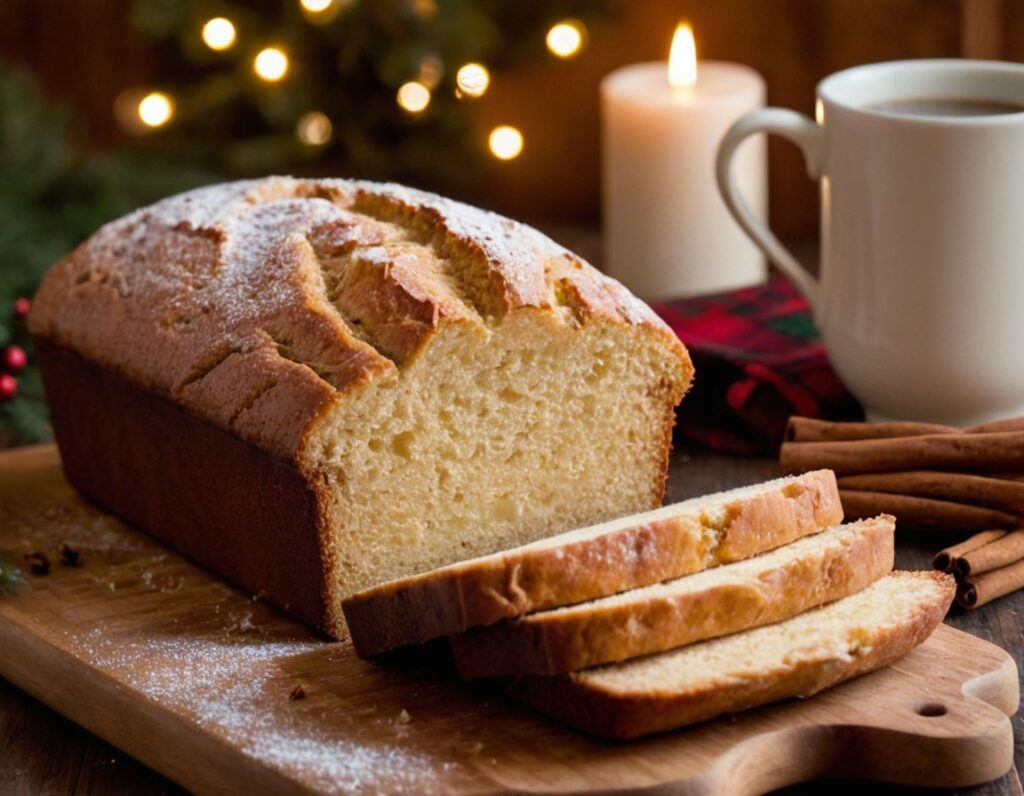
How to Make (Include Full Measurements)
Making eggnog bread is a wonderfully straightforward process, perfect for beginner and experienced bakers alike. With just a few mixing bowls and a loaf pan, you can have a delicious and festive loaf ready for the oven in under 20 minutes. Here’s a step-by-step guide to ensure your eggnog bread turns out moist, flavorful, and beautifully golden every time.
Ingredients Recap (Full Measurements):
- 2 cups all-purpose flour
- 1 cup granulated sugar
- 2 teaspoons baking powder
- ½ teaspoon salt
- 1 teaspoon ground nutmeg
- ½ teaspoon ground cinnamon
- 2 large eggs
- 1 cup non-alcoholic eggnog
- ½ cup unsalted butter, melted
- 1½ teaspoons vanilla extract
- Optional: ½ cup chopped pecans or walnuts
- Optional: ¼ cup dried cranberries
For the Glaze (Optional):
- 1 cup powdered sugar
- 2–3 tablespoons non-alcoholic eggnog
Instructions:
Step 1: Preheat and Prepare
Start by preheating your oven to 350°F (175°C). Lightly grease a 9×5-inch loaf pan with nonstick spray or line it with parchment paper for easy removal. Set the pan aside while you prepare the batter.
Step 2: Mix the Dry Ingredients
In a large mixing bowl, whisk together the all-purpose flour, sugar, baking powder, salt, nutmeg, and cinnamon. This step ensures even distribution of leavening and spices, which is key to a consistent rise and flavor throughout the loaf.
Step 3: Combine the Wet Ingredients
In a medium bowl, whisk the eggs until well beaten. Add the eggnog, melted butter (make sure it’s slightly cooled), and vanilla extract. Mix until everything is thoroughly combined.
Step 4: Combine Wet and Dry Mixtures
Make a well in the center of the dry ingredients and pour the wet mixture into it. Using a rubber spatula or wooden spoon, gently stir until just combined. Be careful not to overmix, as this can lead to a tough, dense loaf.
Step 5: Add Extras (Optional)
If using chopped nuts or dried cranberries, gently fold them into the batter at this stage. These add-ins give the loaf extra texture and flavor but are completely optional.
Step 6: Pour and Bake
Transfer the batter to your prepared loaf pan and smooth the top. Place the pan in the center of your preheated oven and bake for 45 to 55 minutes. Begin checking at the 45-minute mark by inserting a toothpick into the center of the loaf; it should come out clean or with just a few moist crumbs.
Step 7: Cool and Glaze
Allow the bread to cool in the pan for about 10 minutes before transferring it to a wire rack. Once fully cooled, whisk together the powdered sugar and eggnog to form a thick but pourable glaze. Drizzle it over the cooled loaf for a sweet finish.
And that’s it! With minimal prep and effort, you’ve created a festive loaf that’s packed with seasonal flavors and perfect for sharing.
Serving and Storage Tips
Eggnog bread is incredibly versatile when it comes to serving options. It’s not just a holiday treat—it’s a loaf that can be enjoyed for breakfast, dessert, or even a midday snack. The warm spices and creamy richness make it a standout dish for festive occasions, but it’s simple enough to enjoy any time you’re craving a cozy bite of something sweet.
Serving Ideas:
- For Breakfast or Brunch: Serve thick slices of eggnog bread warm, either plain or lightly toasted with a pat of butter. It pairs wonderfully with coffee, tea, or a warm cup of non-alcoholic spiced cider.
- As Dessert: Top a slice with a dollop of whipped cream or a scoop of vanilla ice cream and drizzle a bit of caramel sauce over the top. The spices and glaze complement rich, creamy toppings beautifully.
- Holiday Platter: Include slices of eggnog bread on a dessert tray alongside holiday cookies, fruitcake, and fudge. It adds variety in texture and flavor while still fitting into a festive spread.
- Gifting: Wrapped in parchment and tied with a ribbon, this bread makes a thoughtful homemade gift for neighbors, teachers, or holiday guests. Just be sure to include a note about storage instructions if gifting glazed versions.
Storage Tips:
At Room Temperature:
Eggnog bread will stay fresh for up to 3 days when stored in an airtight container or tightly wrapped in plastic wrap at room temperature. Keep it away from direct sunlight or heat sources.
Refrigeration:
To extend its freshness, refrigerate the bread. It will last up to 6 days in the fridge. Make sure it’s sealed well to prevent it from drying out or absorbing odors.
Freezing:
Eggnog bread freezes exceptionally well. Wrap the loaf (whole or sliced) in a layer of plastic wrap and then a layer of aluminum foil. Place it in a zip-top freezer bag, and it will stay good for up to 3 months. When ready to enjoy, thaw the loaf overnight in the refrigerator or at room temperature for several hours. For slices, a quick zap in the microwave (about 15–20 seconds) brings them back to a warm, just-baked feel.
Storing Glazed Bread:
If you’ve already glazed your bread, let the glaze set completely before wrapping. For long-term freezing, consider freezing the loaf unglazed and adding the glaze fresh once thawed for best texture and appearance.
Whether you’re serving this for guests or saving it all for yourself (we don’t blame you!), eggnog bread is a reliable and delicious treat that stores beautifully and tastes even better the next day.
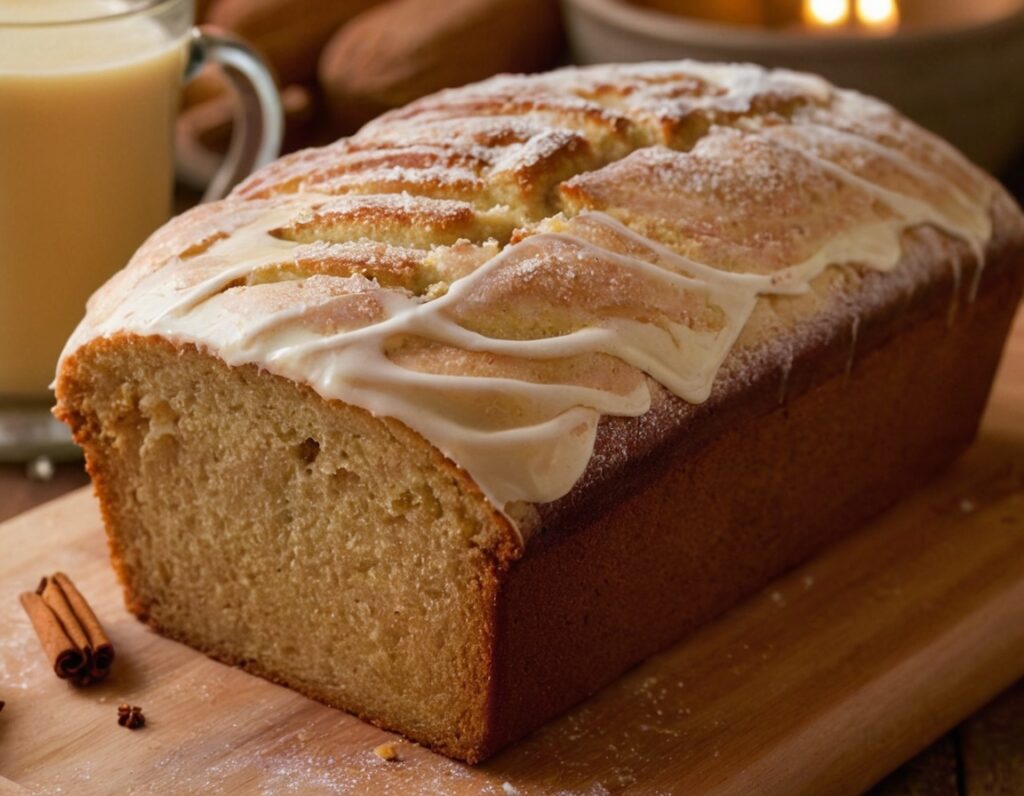
Mistakes to Avoid
Even though eggnog bread is a relatively simple recipe, a few common missteps can prevent it from reaching its full potential. Whether you’re a first-time baker or someone with a pantry full of flour and baking powder, being aware of these pitfalls can help ensure that your loaf turns out moist, flavorful, and just the right texture every time. Below are the most important mistakes to avoid when making eggnog bread:
1. Overmixing the Batter
This is the number one issue that can turn a dreamy loaf into a dense or rubbery brick. Eggnog bread relies on a tender crumb, and overmixing activates too much gluten, which leads to toughness. The batter should be stirred just until the dry ingredients are moistened. A few lumps are okay! Using a spatula instead of a whisk can also help prevent overmixing.
2. Not Using Room Temperature Ingredients
It may seem like a small detail, but room temperature eggs and melted butter blend more evenly with eggnog and flour, resulting in a smoother batter. Cold eggs can cause the melted butter to seize up and make the batter clumpy. For best results, set your ingredients out about 30 minutes before you start baking.
3. Skipping the Sift
When dry ingredients like flour, baking powder, and sugar are packed or compacted, it can lead to uneven mixing. Take a moment to whisk or sift them together before combining with wet ingredients. This ensures the leavening agents are distributed evenly throughout the batter and leads to a more uniform rise.
4. Ignoring the Oven Temperature
Not all ovens are calibrated correctly, and baking at a higher or lower temperature can drastically change the outcome. If your oven runs hot, the outside of the bread may cook too fast while the inside remains underdone. Using an oven thermometer to verify the correct temperature—350°F—is always a good habit.
5. Not Greasing the Pan Properly
There’s nothing more disappointing than a beautifully risen loaf that sticks to the pan. Make sure to grease your loaf pan thoroughly or line it with parchment paper. If using butter to grease the pan, dust it lightly with flour as well.
6. Opening the Oven Too Early
It’s tempting to peek in on your eggnog bread while it’s baking, but opening the oven door too early in the baking process can cause the loaf to deflate. Wait until at least 40 minutes have passed before doing your first toothpick test for doneness.
7. Pouring Glaze on a Hot Loaf
Adding glaze to a warm loaf might seem like a shortcut, but it will melt right off or soak in too much, making the top soggy. Always wait until the bread has cooled completely before glazing. This ensures the glaze sits on top beautifully for a clean finish and better taste.
Avoiding these common mistakes is the difference between a mediocre loaf and a bakery-worthy one. Being mindful of technique and taking your time will always pay off when it comes to baking!
Tips and Tricks
If you’re looking to take your eggnog bread to the next level or simply want to make the process even smoother, these practical tips and clever tricks can help you achieve bakery-style results right in your own kitchen. Whether you’re baking for the holidays or just craving something cozy, these suggestions will give your loaf that extra edge.
1. Use High-Quality Eggnog
Not all eggnogs are created equal. For best results, choose a thick, creamy, non-alcoholic eggnog with a strong vanilla and nutmeg flavor. Plant-based eggnogs like oat or almond also work well if you’re dairy-free, but make sure they’re not overly watery or it could impact the structure of the bread.
2. Add a Crunchy Topping
For a bakery-style crust, sprinkle a little raw sugar, chopped nuts, or cinnamon sugar on top of the batter before baking. This adds a satisfying texture and a little sparkle to the finished loaf.
3. Double the Recipe for Gifting
Eggnog bread freezes and stores well, making it an excellent gift during the holidays. Consider doubling the recipe and baking in mini loaf pans. Tie with a ribbon and include a note with reheating instructions—it’s thoughtful and delicious!
4. Customize the Spices
You’re not limited to just cinnamon and nutmeg. Feel free to experiment with allspice, ground cloves, or even cardamom for a more complex flavor. Just be careful not to go overboard—start with ¼ teaspoon when adding new spices.
5. Make Muffins Instead
Want single-serve versions of your eggnog bread? Turn the batter into muffins! Just line a muffin tin with paper liners, fill each about ¾ full, and bake at 350°F for 18–22 minutes. They make perfect grab-and-go holiday treats.
6. Add a Cream Cheese Swirl
For a richer and more decadent loaf, swirl a mixture of cream cheese, powdered sugar, and a touch of eggnog into the top of the batter before baking. This trick gives your bread a cheesecake-like layer that feels indulgent and festive.
7. Toast Slices Before Serving
To bring out the cozy flavors, try toasting individual slices in a pan with a touch of butter. The edges get crispy, and the warmth enhances the nutmeg and cinnamon. It’s like dessert and breakfast all in one.
8. Pair with a Holiday Beverage
Eggnog bread goes beautifully with a hot drink. Try serving it alongside chai tea, hot cocoa, a spiced latte, or warm milk with cinnamon. If you’re hosting, offering slices with different drinks adds a special touch to your table.
Whether you’re dressing it up with glaze and toppings or sticking to the classic version, eggnog bread is full of potential for customization. Use these tips to tailor the recipe to your liking and make it an unforgettable seasonal staple.
Suggestions
Eggnog bread may already sound indulgent on its own, but there are endless ways to customize and elevate this cozy holiday loaf depending on the occasion, audience, or personal taste preferences. Whether you’re serving it at a festive brunch, giving it as a homemade gift, or just baking to fill your kitchen with seasonal aromas, these suggestions will help you find new ways to enjoy and present this flavorful treat.
1. Make It a Dessert Centerpiece
While eggnog bread is often seen as a breakfast or snack loaf, with a few simple upgrades, it can be transformed into a dessert-worthy centerpiece. Top it with a thick cream cheese glaze, sprinkle crushed candied pecans, or drizzle with a cinnamon-spiced caramel sauce. Add a dusting of powdered sugar for a snowy effect during the winter holidays. Serve it on a cake stand with garnishes like fresh cranberries or orange zest spirals for a picture-perfect display.
2. Serve with a Spread
Although the bread is moist and flavorful on its own, pairing it with a festive spread can add an extra layer of indulgence. Try cinnamon honey butter, maple cream cheese, or even a cranberry-orange compote. If you’re offering this bread for a brunch spread, serving a variety of spreads allows your guests to personalize their slice.
3. Create a Trifle or Parfait
Repurpose leftover slices by layering them with whipped cream, vanilla pudding, and fresh berries or stewed apples in a glass trifle dish. This is a smart and beautiful way to use up dry ends or slightly stale bread. The bread absorbs the flavors of the cream and fruit, resulting in a rich, pudding-like dessert.
4. Holiday Gift Idea
Eggnog bread makes an ideal edible gift, especially during the colder months. Bake in decorative paper loaf pans or mini tins, wrap in festive parchment or plastic wrap, and finish with a ribbon and tag. You can also print the recipe and attach it as part of the gift. It’s a thoughtful, homemade present for neighbors, teachers, or coworkers.
5. Make it Gluten-Free or Vegan
For gluten-free eaters, use a 1:1 gluten-free baking flour that includes xanthan gum for structure. For vegan adaptations, substitute dairy-free eggnog (like almond or oat-based), use flax eggs (1 tbsp ground flaxseed + 2.5 tbsp water per egg), and replace butter with coconut oil or a plant-based butter alternative. Keep in mind that flavor and texture may vary slightly, so test a small batch first.
6. Incorporate Mix-Ins
Add-ins like chopped pecans, walnuts, dried cranberries, white chocolate chips, or shredded coconut can completely change the profile of your eggnog bread. Fold in up to ¾ cup of your favorite extras before baking. Keep in mind that moist ingredients, like fruit, may require a slightly longer bake time.
7. Kid-Friendly Version
To make this bread more appealing for kids, try using mini loaf pans or muffin tins and top each with festive sprinkles or a cinnamon glaze. Using a touch more vanilla and a little less nutmeg can create a more universally loved flavor.
8. Brunch Board Inclusion
Add eggnog bread slices to a winter brunch board featuring fruit, cheese, pastries, spreads, and warm drinks. It adds variety and helps balance savory options with something sweet and seasonal.
These ideas are meant to encourage you to get creative with your eggnog bread recipe. From flavor enhancements to festive presentation, there are countless ways to turn this humble loaf into something truly spectacular.
FAQ
When it comes to making eggnog bread, especially for the first time, a few questions often come up. Below are answers to the most common queries to help ensure your baking experience is stress-free, successful, and as delicious as possible.
Q: Can I use homemade eggnog in this recipe?
A: Yes, you can absolutely use homemade eggnog as long as it’s non-alcoholic. Just be sure it’s thick and well-spiced for the best flavor impact. Keep in mind that store-bought eggnog is usually pasteurized and consistent in texture, so if your homemade version is thinner, you may want to reduce other liquids slightly.
Q: What can I use instead of eggnog?
A: If you’re looking to bake this outside of the holiday season or want an eggnog-free version, you can use whole milk mixed with 1 teaspoon of vanilla extract and a pinch of nutmeg as a substitute. For dairy-free options, try oat milk or almond milk with similar spicing added.
Q: Can I freeze eggnog bread?
A: Yes, eggnog bread freezes beautifully. Once it’s fully cooled, wrap it tightly in plastic wrap and then foil, or place in a zip-top freezer bag. It will stay fresh in the freezer for up to 2 months. To serve, let it
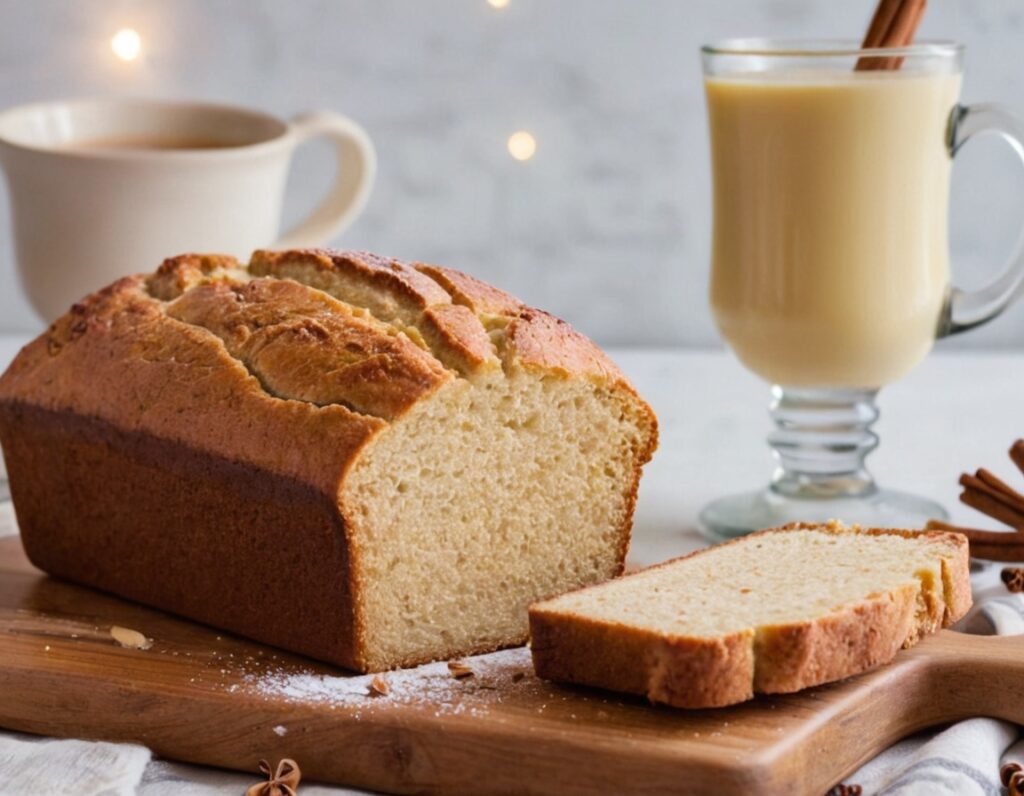
Conclusion
Eggnog bread is more than just a seasonal baked good—it’s a warm and inviting reminder of holiday traditions, family gatherings, and cozy winter moments. Whether you’re baking it for Christmas morning, gifting it to a friend, or simply indulging in a comforting slice with a mug of tea, this quick bread delivers rich flavor and festive charm. With its tender crumb, signature eggnog taste, and hints of nutmeg and cinnamon, it strikes the perfect balance between nostalgic and modern.
The beauty of eggnog bread lies in its simplicity and versatility. You don’t need to be an expert baker to make it; the recipe is straightforward, the ingredients are easy to find, and the process doesn’t require any special equipment or advanced techniques. Yet, despite its simplicity, the results are always impressive. The golden loaf looks beautiful straight from the oven, especially when dressed up with a glaze or streusel topping.
Beyond taste and texture, this bread serves as a creative outlet in the kitchen. You can easily make it your own by experimenting with mix-ins, glazes, or presentation. It can transition seamlessly from a casual breakfast to an elegant dessert with just a few thoughtful additions. It’s also a wonderful make-ahead option—perfect for those busy holiday weeks when you need something ready to go.
From a nutrition standpoint, it’s a treat—meant to be savored and shared. But even so, you can find ways to tailor it to your dietary preferences without losing the joy of the recipe. Vegan versions, gluten-free adaptations, or sugar-conscious tweaks are all possible with a little planning.
Eggnog bread represents everything that’s wonderful about baking: it brings people together, fills the home with delicious aromas, and turns everyday ingredients into something special. So whether you’re a holiday enthusiast or simply love trying new bakes, this loaf deserves a spot in your seasonal rotation. It’s a surefire crowd-pleaser that combines classic flavors with the kind of cozy appeal only homemade baked goods can deliver.
